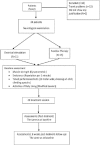The effects of electrical stimulation and exercise therapy in patients with limb girdle muscular dystrophy. A controlled clinical trial
- PMID: 26166595
- PMCID: PMC4710330
- DOI: 10.17712/nsj.2015.3.201501097
The effects of electrical stimulation and exercise therapy in patients with limb girdle muscular dystrophy. A controlled clinical trial
Abstract
Objective: To evaluate and compare the effects of exercise therapy and electrical stimulation on muscle strength and functional activities in patients with limb-girdle muscular dystrophy (LGMD).
Methods: This controlled clinical trial included 24 subjects who were diagnosed with LGMD by the Neurology Department of the Hacettepe University Hospital, Ankara, Turkey and were referred to the Physical Therapy Department between May 2013 and December 2014. Subjects were enrolled into an electrical stimulation (11 patients) group, or an exercise therapy (13 patients) group.
Results: The mean age of patients was 31.62 years in the electrical stimulation group, and 30.14 years in the exercise therapy group. The most important results in this controlled clinical study were that the muscle strength in both groups was significantly decreased and post-treatment evaluation results indicated that muscle strength of the Deltoideus was higher in the electrical stimulation group, and the difference between the groups was maintained in the follow-up period (p<0.05). However, the muscle strength of quadriceps was similar in both groups, according to the post-treatment and follow-up evaluation results (p>0.05). Additionally, the electrical stimulation group presented more obvious overall improvements than the exercise therapy group according to muscle strength, endurance, and timed performance tests.
Conclusion: Since no definitive treatments currently exist for patients with LGMD, these results provide important information on the role of exercise therapy and electrical stimulation for clinicians working in rehabilitation.
Figures
References
-
- Guglieri M, Magri F, D’Angelo MG, Prelle A, Morandi L, Rodolico C, et al. Clinical, molecular, and protein correlations in a large sample of genetically diagnosed Italian limb girdle muscular dystrophy patients. Hum Mutat. 2008;29:258–266. - PubMed
-
- Stübgen JP. Limb girdle muscular dystrophy: an interval study of weakness and functional impairment. J Clin Neuromuscul Dis. 2008;9:333–340. - PubMed
-
- Bushby K. Diagnosis and management of the limb girdle muscular dystrophies. Pract Neurol. 2009;9:314–323. - PubMed
-
- Krivickas LS. Exercise in neuromuscular disease. J Clin Neuromuscul Dis. 2003;5:29–39. - PubMed
-
- Cup EH, Pieterse AJ, Ten Broek-Pastoor JM, Munneke M, van Engelen BG, Hendricks HT, et al. Exercise therapy and other types of physical therapy for patients with neuromuscular diseases: a systematic review. Arch Phys Med Rehabil. 2007;88:1452–1464. - PubMed
Publication types
MeSH terms
LinkOut - more resources
Full Text Sources
Other Literature Sources

